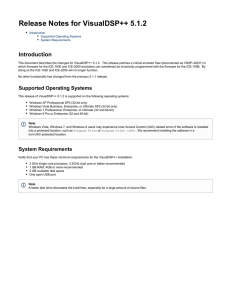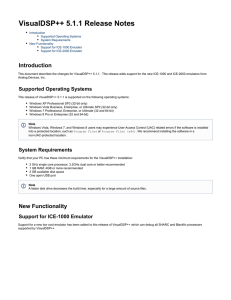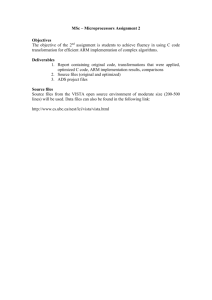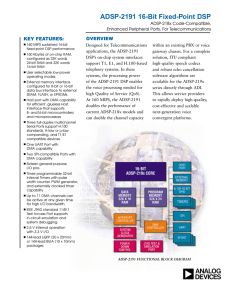a Engineer-to-Engineer Note EE-330
advertisement
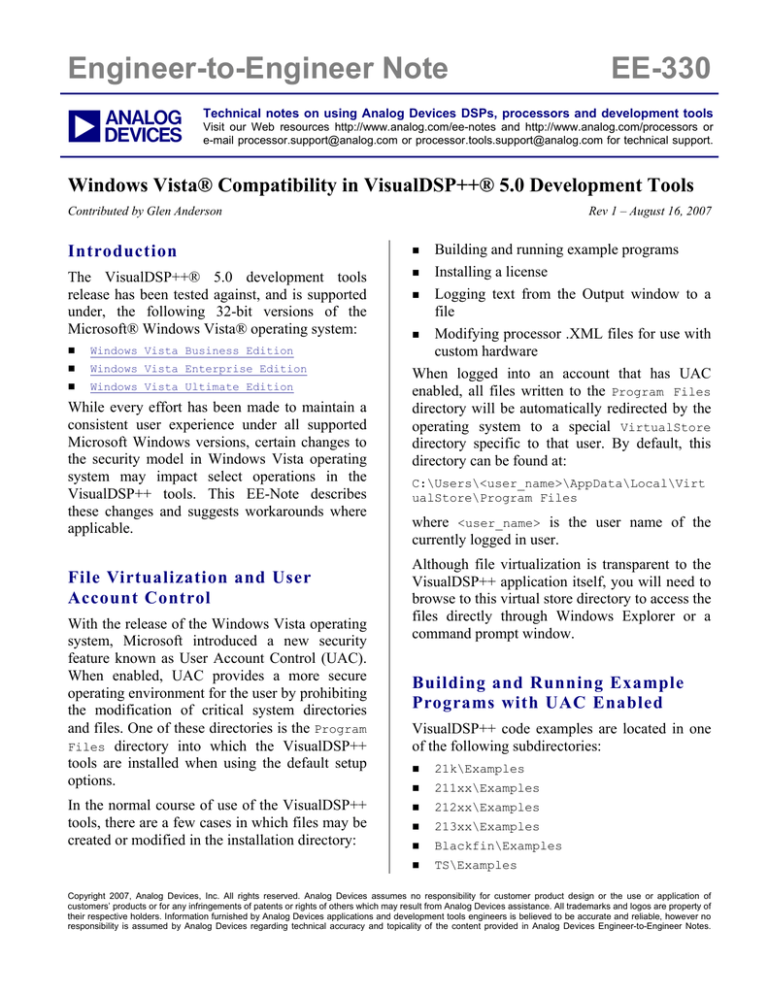
Engineer-to-Engineer Note a EE-330 Technical notes on using Analog Devices DSPs, processors and development tools Visit our Web resources http://www.analog.com/ee-notes and http://www.analog.com/processors or e-mail processor.support@analog.com or processor.tools.support@analog.com for technical support. Windows Vista® Compatibility in VisualDSP++® 5.0 Development Tools Contributed by Glen Anderson Introduction The VisualDSP++® 5.0 development tools release has been tested against, and is supported under, the following 32-bit versions of the Microsoft® Windows Vista® operating system: Windows Vista Business Edition Windows Vista Enterprise Edition Windows Vista Ultimate Edition While every effort has been made to maintain a consistent user experience under all supported Microsoft Windows versions, certain changes to the security model in Windows Vista operating system may impact select operations in the VisualDSP++ tools. This EE-Note describes these changes and suggests workarounds where applicable. File Virtualization and User Account Control With the release of the Windows Vista operating system, Microsoft introduced a new security feature known as User Account Control (UAC). When enabled, UAC provides a more secure operating environment for the user by prohibiting the modification of critical system directories and files. One of these directories is the Program Files directory into which the VisualDSP++ tools are installed when using the default setup options. In the normal course of use of the VisualDSP++ tools, there are a few cases in which files may be created or modified in the installation directory: Rev 1 – August 16, 2007 Building and running example programs Installing a license Logging text from the Output window to a file Modifying processor .XML files for use with custom hardware When logged into an account that has UAC enabled, all files written to the Program Files directory will be automatically redirected by the operating system to a special VirtualStore directory specific to that user. By default, this directory can be found at: C:\Users\<user_name>\AppData\Local\Virt ualStore\Program Files where <user_name> is the user name of the currently logged in user. Although file virtualization is transparent to the VisualDSP++ application itself, you will need to browse to this virtual store directory to access the files directly through Windows Explorer or a command prompt window. Building and Running Example Programs with UAC Enabled VisualDSP++ code examples are located in one of the following subdirectories: 21k\Examples 211xx\Examples 212xx\Examples 213xx\Examples Blackfin\Examples TS\Examples Copyright 2007, Analog Devices, Inc. All rights reserved. Analog Devices assumes no responsibility for customer product design or the use or application of customers’ products or for any infringements of patents or rights of others which may result from Analog Devices assistance. All trademarks and logos are property of their respective holders. Information furnished by Analog Devices applications and development tools engineers is believed to be accurate and reliable, however no responsibility is assumed by Analog Devices regarding technical accuracy and topicality of the content provided in Analog Devices Engineer-to-Engineer Notes. a When UAC is enabled, any files created as a result of building one of these examples will be transparently redirected to your VirtualStore directory. To access these files, do one of two things: Manually browse to the appropriate Examples folder under your VirtualStore directory, as listed above. Browse to the ‘real’ directory under C:\Program Files and click on the toolbar link titled Compatibility Files to go directly to the corresponding VirtualStore directory. Installing a License with UAC Enabled Licenses in the VisualDSP++ tools are stored in a file called license.dat, located within the System directory of your VisualDSP++ installation folder. When installing a new license with UAC enabled, changes to this file will be redirected to your VirtualStore directory. Because VirtualStore directories are specific to each user, this has the added side effect in that other users on the machine will not have access to these licenses when using the VisualDSP++ tools. If you would like to install licenses such that they can be used by all users of the computer, you will need to install them using account credentials that have administrator rights on that machine. This can be accomplished as follows: Figure 1. Compatibility Files link in toolbar while viewing the directory in which the application files would normally have been created 1. Click on the Windows Start menu and browse to the Manage Licenses icon for the VisualDSP++ installation for which you wish to manage the license. 2. Right-click on this icon and select Run as administrator from the context menu. 3. When prompted, enter the user name and password for an account that has administrator rights on the machine. Follow the normal steps for installing or validating a new license, as described in the VisualDSP++ documentation. The license.dat file will be created in the Program Files directory, which can then be accessed by all users of the computer. Figure 2. Clicking the Compatibility Files link opens the corresponding folder in your VirtualStore where the example results can be found L If you will be the only user of VisualDSP++ tools on this particular computer, no further action is required. Windows Vista® Compatibility in VisualDSP++® 5.0 Development Tools (EE-330) Page 2 of 4 a processor .XML files, located in the following directory: C:\Program Files\Analog Devices\VisualD SP++ 5.0\System\ArchDef With UAC enabled, changes to these files will be disallowed, given that they are stored in the protected Program Files directory. Figure 3. Installing a license that can be used by all machine users Viewing the Console Window Log File with UAC Enabled By default, the VisualDSP++ IDDE logs all text written to the Output window to the following file: C:\Program Files\Analog Devices\VisualD SP++ 5.0\Data\VisualDSP_Log.txt When UAC is enabled, this file can be found in the user’s VirtualStore directory: C:\Users\<user_name>\AppData\Local\Virt ualStore Program Files\Analog Devices\V isualDSP++ 5.0\Data\VisualDSP_Log.txt With the VisualDSP++ 5.0 release, a new feature known as ‘custom board support’ allows you to override these values in a separate .XML file stored in the directory of your choosing. L It is no longer necessary, nor recommended, that you modify the .XML files installed with VisualDSP++ tools. More information on creating custom board support files can be found in VisualDSP++ Help, which is installed with the VisualDSP++ 5.0 tools. In Help, look under the heading: Graphical Environment -> Custom Board Support For More Information Modifying Processor .XML Files for Use with Custom Hardware More information on UAC and file virtualization can be found in the Knowledge Base [4] on Microsoft’s Web site at: In versions of the VisualDSP++ tools prior to 5.0, it was sometimes necessary to modify the register definitions and reset values found in the http://support.microsoft.com/ Windows Vista® Compatibility in VisualDSP++® 5.0 Development Tools (EE-330) Page 3 of 4 a References [1] Windows Vista Business (http://www.microsoft.com/windows/products/windowsvista/editions/business). June 2007. Microsoft Corporation. [2] Windows Vista Enterprise (http://www.microsoft.com/windows/products/windowsvista/editions/enterprise). June 2007. Microsoft Corporation. [3] Windows Vista Ultimate (http://www.microsoft.com/windows/products/windowsvista/editions/ultimate). June 2007. Microsoft Corporation. [4] Common file and registry virtualization issues in Windows Vista (http://support.microsoft.com/kb/927387). Rev 2.5, March 15, 2007. Microsoft Corporation. [5] VisualDSP++ 5.0 Licensing Guide. Rev 1.0, August 2007. Analog Devices, Inc. Readings [6] The Windows Vista and Windows "Longhorn" Server Developer Story: Windows Vista Application Development Requirements for User Account Control (UAC) (http://msdn2.microsoft.com/en-us/library/aa905330.aspx). April 2007. Microsoft Corporation. Document History Revision Description Rev 1 – August 16, 2007 by Glen Anderson Initial Release Windows Vista® Compatibility in VisualDSP++® 5.0 Development Tools (EE-330) Page 4 of 4
